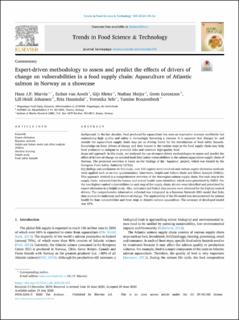| dc.contributor.author | Marvin, Hans J.P. | |
| dc.contributor.author | van Asselt, Esther | |
| dc.contributor.author | Kleter, Gijs | |
| dc.contributor.author | Meijer, Nathan | |
| dc.contributor.author | Lorentzen, Grete Elisabeth | |
| dc.contributor.author | Johansen, Lill-Heidi | |
| dc.contributor.author | Hannisdal, Rita | |
| dc.contributor.author | Sele, Veronika | |
| dc.contributor.author | Bouzembrak, Yamine | |
| dc.date.accessioned | 2020-10-15T12:12:22Z | |
| dc.date.available | 2020-10-15T12:12:22Z | |
| dc.date.created | 2020-08-01T12:28:15Z | |
| dc.date.issued | 2020 | |
| dc.identifier.citation | Trends in Food Science & Technology. 2020, 103 49-56. | en_US |
| dc.identifier.issn | 0924-2244 | |
| dc.identifier.uri | https://hdl.handle.net/11250/2683090 | |
| dc.description.abstract | In the last decades, food produced by aquaculture has seen an impressive increase worldwide but maintaining high quality and safety is increasingly becoming a concern. It is apparent that changes in- and outside the aquaculture supply chain may act as driving forces for the introduction of food safety hazards. Knowledge on these drivers of change and their impact in the various steps in the food supply chain may help food producers to mitigate to potential risks and maintain high-quality food. | en_US |
| dc.language.iso | eng | en_US |
| dc.title | Expert-driven methodology to assess and predict the effects of drivers of change on vulnerabilities in a food supply chain: Aquaculture of Atlantic salmon in Norway as a showcase | en_US |
| dc.type | Peer reviewed | en_US |
| dc.type | Journal article | en_US |
| dc.description.version | publishedVersion | en_US |
| dc.source.pagenumber | 49-56 | en_US |
| dc.source.volume | 103 | en_US |
| dc.source.journal | Trends in Food Science & Technology | en_US |
| dc.identifier.doi | 10.1016/j.tifs.2020.06.022 | |
| dc.identifier.cristin | 1821176 | |
| cristin.ispublished | true | |
| cristin.fulltext | original | |
| cristin.qualitycode | 2 | |
